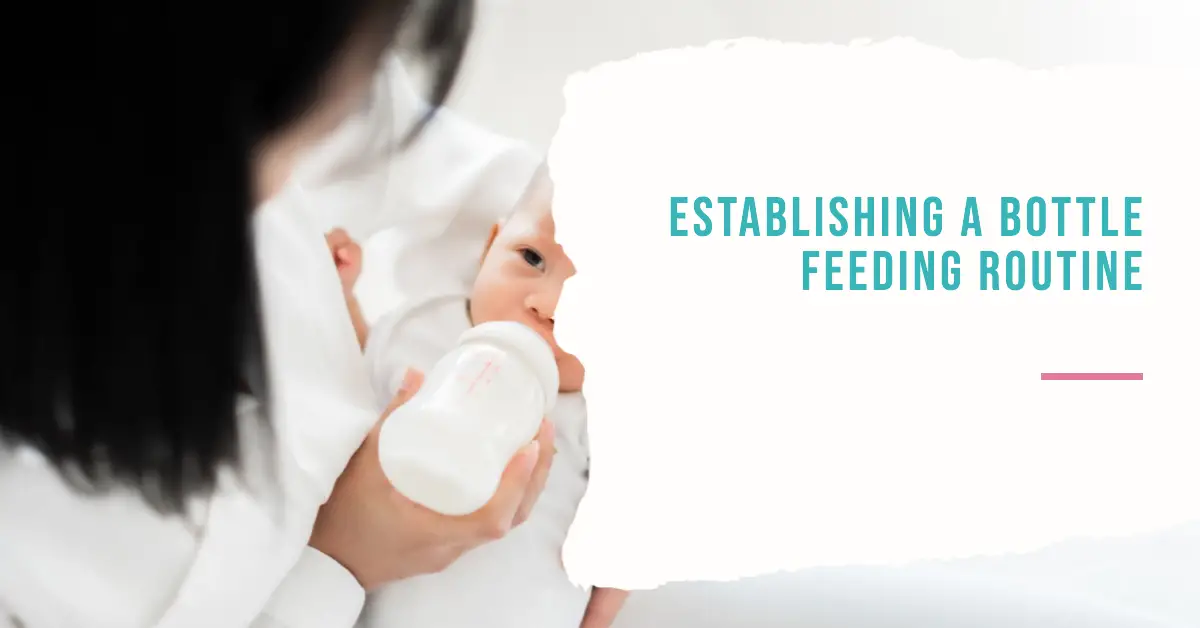As a pediatric nutritionist/dietitian, I am passionate about helping parents create healthy and safe routines for their little ones. Establishing an appropriate bottle-feeding routine is essential to ensure the health of infants, both physically and emotionally. A well-balanced diet will give your baby all the nutrients they need to grow strong and thrive!
This article offers guidance on how to establish a routine that works best for you and your baby. Bottle feeding can be overwhelming for new parents but with some patience and practice, it doesn’t have to be stressful. By following these steps, you can help make sure your baby gets the nourishment they need while also establishing a happy bonding experience between parent and child.
Let’s get started so your family can benefit from this important parenting milestone!
Table of Contents
- Choosing The Right Bottle
- Preparing The Bottle
- Scheduling Feedings
- Paying Attention To Baby’s Cues
- Spotting Signs Of Fullness
- Properly Handling And Storing Of Formula
- Hygienic Practices During Feeding
- Introducing Solid Foods
- When To Wean
- Practicing Safe Feeding Habits
- Frequently Asked Questions
- How Much Formula Should I Give My Baby At Each Feeding?
- How Do I Know If My Baby Is Getting Enough Formula?
- How Can I Tell If My Baby Is Reacting To A Certain Type Of Formula?
- How Often Should I Change The Bottle And Nipple?
- Are There Any Special Techniques To Help My Baby Transition From Bottle To Solid Food?
- Conclusion
Choosing The Right Bottle
When it comes to choosing the right bottle for your little one, there are a few things you must consider.
The material of the bottle is an important factor; silicone and plastic bottles can be easier to clean than glass bottles as they don’t break as easily. However, with plastic bottles, ensure that BPA-free materials are being used for safety reasons.
Additionally, make sure to choose the appropriate size for your baby. Smaller 3 oz – 6 oz sizes may be great for newborns who eat less at once, while larger 9 oz – 12 oz sizes might suit older babies better.
No matter which type or size of bottle you choose, remember that helping your child establish a healthy feeding routine begins with finding the perfect fit!
As you continue on this journey together, preparing their bottles will become second nature – so let’s get started!
Preparing The Bottle
Preparing the bottle is an important step in establishing a successful feeding routine. It’s essential to make sure that you clean, sterilize and check the temperature of your baby’s bottle before every feed.
Cleaning can be easily done with warm water and a sponge or brush specifically designed for bottles. If using powder formula, it’s also recommended to use hot water when cleaning the bottle to dissolve any lumps.
Sterilizing should only be done if advised by your healthcare provider and can be either through boiling or special electric steamers.
Finally, checking for temperature is key; too cold or too hot milk can cause discomfort for your baby so always test the temperature on your wrist before giving it to them!
As long as all these steps are taken then you should feel confident about providing your little one with their next mealtime treat!
Scheduling Feedings
Creating a bottle feeding routine is essential for your baby’s nutrition and growth. Scheduling feedings allows you to have control over the timing, amount of food consumed and temperature of the formula or breast milk; all of which are important factors in keeping your baby healthy.
Here are five tips that can help you get started:
- Set an interval between feedings so that it becomes a habit. This will give your baby structure while ensuring they consume enough nutrients at each mealtime.
- Feeding times should be based on your baby’s age and size as their nutritional needs vary with development. For example, newborn babies may need to eat every two to three hours whereas older infants may not need to eat as often.
- Ensure that the bottle has the right temperature when serving meals. If using formula powder, room temperature water should be used instead of cold or warm water. Hot water could potentially burn your infant’s mouth and throat lining if heated too much, making eating uncomfortable for them.
- Try creating a chart with timestamps for each feeding time as this can make scheduling easier for both parents and caregivers alike! It also helps keep track of how much fluid intake occurs throughout the day so any changes can be quickly adapted if needed.
- Make sure there is adequate rest time between feeds – too many consecutive bottles without breaks can cause stomach discomfort or even reflux in some cases. Allow 30 minutes minimum between feedings before giving another one (if necessary).
Always pay attention to your baby’s cues such as crying or fussiness during mealtimes – these signs indicate hunger but also might mean that they’re full up already after just a few swallows! Be mindful of what works best for them so you can adjust accordingly.
By following these guidelines, establishing a bottle feeding routine will become more manageable while providing better nourishment for your little one! The next step is getting familiar with paying attention to your baby’s cues; doing this will ensure meals are tailored specifically towards their individual needs and preferences.
Paying Attention To Baby’s Cues
When it comes to bottle feeding, the key is to pay attention to your baby’s hunger cues. Reading those cues will help you understand when they are ready for a feed and how much nutrition they need at that time. It might seem tricky in the beginning, but with practice and patience you’ll be able to recognize what their needs are quickly.
Identifying signs of fullness can also help you guide them through this routine. You don’t want to overfeed your little one; understanding how long each feed should last helps ensure that doesn’t happen.
To spot these signs, watch out for physical signals like turning their head away or closing their mouth when offered food, as well as verbal ones such as crying or fussing after eating certain amounts. Remember that every baby is different, so always listen closely and adapt accordingly.
With attentive care and some trial-and-error, you’ll soon get into a comfortable groove! Moving forward, let’s look at how we can spot signs of fullness effectively.
Spotting Signs Of Fullness
It is vital to recognize the subtle cues of your baby’s hunger. As you become more familiar with your bundle of joy, you’ll gain a better understanding of what they need and when they need it.
Being able to spot signs that your baby may be full or hungry can help you create an appropriate bottle feeding routine for them.
When preparing formula for your infant, finding the right size bottles and nipples is important as well.
A larger nipple hole can cause babies to take in too much milk too quickly, leading to gas and other digestive issues.
If a smaller hole doesn’t allow enough air flow while they are drinking, this could lead to excessive air intake and possibly even choking from the increased amount of bubbles in their system.
You should also keep in mind that if your little one needs additional nourishment after feedings then there are larger capacity bottles available for those special occasions.
Creating a successful bottle-feeding routine requires paying attention to all the necessary elements; including recognizing both hunger and fullness cues and finding an appropriate sized bottle and nipple so that everything runs smoothly during each mealtime experience!
Properly Handling And Storing Of Formula
It’s important to properly handle and store formula when establishing a bottle feeding routine. Bottle types play an important role in the process, as different bottles allow for easier handling of formula during feedings. It is beneficial to find bottles that are lightweight and easy to grip while also being durable enough to last through multiple uses.
When it comes to storing formula, there are several things you should keep in mind. Here’s a quick checklist:
- Make sure it’s stored at room temperature or cooler; never above 77°F (25°C).
- Store your formula in its original container and tightly close the lid after each use.
- Never leave prepared formula out at room temperature for more than two hours.
- Discard any unused prepared formula within 24 hours of preparation.
These guidelines will help ensure that the infant receives nutrition without risk of contamination from improper storage or handling.
Remembering these basic tips can go a long way towards making sure that your baby gets the best possible nutrition from their bottle feeding routine!
Now let’s turn our attention hygienic practices during feeding – an equally crucial part of maintaining a healthy bottle feeding routine.
Hygienic Practices During Feeding
As a parent, it is important to ensure proper hygiene practices during bottle feeding for your baby.
A key factor of establishing a healthy routine is sanitizing the utensils used beforehand. Any bottles or nipples that have been pre-prepared must be washed and allowed enough time to air dry before using them again.
It is also essential to thoroughly wash your hands prior to handling food items as well as ensuring all surfaces are properly cleaned.
In this same vein, always make sure you check the temperature of any formula being fed to your baby. Since babies cannot regulate their own body temperatures yet, having too hot or cold milk can cause discomfort.
After warming up the liquid, give it a few shakes and squirt some on the inside of your wrist so that you can make sure it’s not too hot for your little one!
Introducing Solid Foods
Introducing solid foods can be an exciting milestone for both parents and babies. As a pediatric nutritionist/dietitian, I’m here to guide you through this process so that your infant gets off to the best start with healthy eating habits.
First things first: When introducing solids, it’s important to introduce one new food at a time and wait 3-5 days in between each introduction. This helps identify any potential food allergies or sensitivities.
Start with simple pureed vegetables such as carrots, squash, sweet potato or green beans before moving onto protein sources like fish and poultry. If possible, opt for organic ingredients when preparing meals for your little one as they are free from pesticides and other harmful chemicals. Additionally, offering different textures is also key; try mashing avocado or banana instead of blending them into a smooth texture. Remember to make sure your baby is seated upright during mealtime!
Feeding infants doesn’t have to be complicated; by following these simple tips you’ll ensure that your baby has access to all the nutrients necessary for proper growth and development while being exposed to essential tastes and flavors.
Now let’s move on—when do we transition away from bottle feeding?
When To Wean
When it comes to weaning, there are a few important points to consider. First and foremost is that you should always follow your baby’s hunger cues as the primary indicator of when they’re ready for solid foods.
Additionally, the American Academy of Pediatrics recommends introducing solids between 4-6 months old, so here are some key tips for knowing when to make the transition:
- Watch for signs of readiness such as having good head control, sitting up with support and showing an interest in food.
- Gradually introduce age appropriate finger foods around 6-7 months old before beginning purees if desired.
- Introduce new flavors and textures slowly to allow your baby time to adjust while continuing bottle feedings until 12 months or longer depending on their individual needs.
At this stage, it’s also essential to practice safe feeding habits by following proper hygiene techniques such as washing hands and surfaces thoroughly prior to preparing any meals or snacks for infants or toddlers.
With these tips in mind, transitioning your child from formula/breastmilk alone into a more diverse diet can be a fun experience both parent and baby alike!
Practicing Safe Feeding Habits
When it comes to establishing a bottle feeding routine, safety is paramount.
It’s important for parents to understand the differences between breastfeeding and bottle-feeding, as well as how to properly store their baby’s milk or formula.
If you choose to breastfeed your baby, ensure that proper hygiene is maintained by washing hands before and after each feed.
Before preparing a bottle of formula or expressed breastmilk, make sure all utensils are sterilized using boiling water.
The same applies when storing leftover milk – keep it refrigerated right away in an airtight container at 40°F (4°C) or below.
When reheating previously frozen milk, be sure not to overheat it since this can destroy valuable nutrients; instead, warm the liquid gradually until it reaches room temperature.
Above all else, never shake heated milk because the force will create bubbles which might choke your child!
Frequently Asked Questions
How Much Formula Should I Give My Baby At Each Feeding?
As a pediatric nutritionist/dietitian, one of the questions I’m asked most frequently is how much formula should be given to an infant at each feeding. The answer isn’t as simple and straightforward as you may think; it’s important to consider your baby’s individual needs and understand their feeding cues.
Timing intervals between feedings will vary depending on age, growth patterns, and appetite. Generally speaking, newborns typically require 2-3 ounces of formula per feeding for the first few weeks. By 1 month old infants usually take 4-5 ounces every four hours, but this can change quickly as your baby grows older.
Ultimately, it’s best to pay attention to your baby’s hunger signals so that they are fed exactly what they need when necessary – no more or less.
How Do I Know If My Baby Is Getting Enough Formula?
Monitoring your baby’s intake is an important part of establishing a bottle feeding routine.
You can track their intake by making sure that they’re finishing the amount of formula recommended for each age group, and taking note of how often they are eating.
Feeding intervals should be no less than every three hours during the day and four to six hours at night.
If you notice that your baby isn’t consuming enough formula or is having more frequent feedings, it’s time to speak with your pediatrician about adjusting their meals accordingly.
With proper tracking, you’ll have peace of mind knowing your little one is getting all the nutrition they need!
How Can I Tell If My Baby Is Reacting To A Certain Type Of Formula?
Choosing the right formula for your baby can be tricky, so it’s important to monitor their reaction.
If you notice vomiting or other signs of discomfort, this could indicate that they are having an adverse reaction to a certain type of formula.
Pay attention to these signs and consider switching formulas if needed; as a pediatric nutritionist/dietitian I’m here to help support families in making sure our little ones get the best nourishment possible!
How Often Should I Change The Bottle And Nipple?
To ensure your baby’s safety and health, it is important that you change the bottle and nipple regularly.
For example, if you are using a formula for your baby, it is recommended to clean and replace the bottle after each feeding. Additionally, try to limit feedings to every two to three hours during the day; however this may vary depending on age and weight of your baby.
As a pediatric nutritionist/dietitian I recommend cleaning all bottles with hot soapy water or running through a dishwasher before reusing them and changing nipples at least once per month.
This will help promote healthy hygiene practices while establishing a safe routine for both mother and child.
Are There Any Special Techniques To Help My Baby Transition From Bottle To Solid Food?
Switching from bottle to solids can seem like a daunting task, but with the right technique you and your baby will both be adjusting quickly.
Signs of hunger such as crying or smacking their lips are usually an indication that it is time to make the transition.
If you have been keeping track of how often they eat and use this information when deciding what pace to adjust at, it will help establish a successful routine for your little one.
Remember that introducing new foods should also be done in small amounts, so take note of any food sensitivities or allergies during this process.
Making sure your baby has all the essential nutrients they need while providing them with a variety of different tastes is key!
Conclusion
For many parents, establishing a bottle feeding routine can be daunting. However, with some patience and practice it’s an achievable goal that will pay off in the long run.
Research shows that almost 80% of babies reach their developmental milestones on time when they are fed according to a regular schedule.
As your baby’s nutritionist/dietitian, I am here to offer you guidance throughout this process. With my help, you can create a safe and healthy feeding plan for your little one so that he or she gets all the nourishment needed to thrive!
Carrie Walters is a young mother of Nina and Tom, who along with her husband Jake is passionate about helping moms and families find modern solutions to common parenting and lifestyle questions. Together with a team of real moms and medical experts, this young couple share sound advice and proven tips to help make your life easier.
They manage this blog along with other blogs and Youtube channels on similar topics



